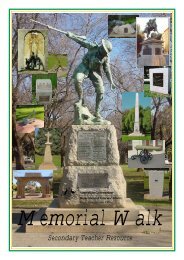Eastern Adelaide Teacher resource.pdf - Army Museum of South ...
Eastern Adelaide Teacher resource.pdf - Army Museum of South ...
Eastern Adelaide Teacher resource.pdf - Army Museum of South ...
Create successful ePaper yourself
Turn your PDF publications into a flip-book with our unique Google optimized e-Paper software.
Memorial Burnside War Memorial Hospital<br />
Address 120 Kensington Road, Toorak Gardens<br />
Background Information<br />
The establishment <strong>of</strong> a community hospital in Burnside was<br />
first suggested in August 1943 at a meeting <strong>of</strong> the Burnside<br />
Council's Post-War Reconstruction and Development<br />
Committee. In November 1943, the council adopted the<br />
committee's recommendation that a hospital costing up to<br />
£100,000 be built and that it become the area's principal<br />
memorial to the fallen service personnel <strong>of</strong> World War I<br />
(Great War) and II.<br />
In February 1944, local resident Mr Otto von Rieben <strong>of</strong>fered<br />
his property Attunga for this purpose. His generous <strong>of</strong>fer<br />
was accepted unanimously by the council and a community<br />
fundraising campaign began. In April 1949, von Rieben's<br />
home was converted into a convalescent hospital for 21<br />
patients as the first part <strong>of</strong> the War Memorial Hospital<br />
scheme. It was closed in September 1956, having cared for<br />
around 1,400 patients.<br />
Burnside War Memorial Hospital was opened on 26 October 1956. Today, Burnside<br />
is a progressive, not-for-pr<strong>of</strong>it private hospital, which underwent a multi-million<br />
dollar redevelopment in 2002.<br />
Student Activities<br />
On Site<br />
(1) In what year was the Burnside War Memorial Hospital opened? (Refer to<br />
the above notes.)<br />
26 October 1956<br />
(2) Examine the War Memorial hanging in the entrance <strong>of</strong> the hospital.<br />
What is the significance <strong>of</strong> the flowers featured in this coloured print?<br />
The hanging establishes the connection between the hospital and its construction as a<br />
‘living’ war memorial following World War II. The flowers featured on the hanging<br />
are poppies. In English literature <strong>of</strong> the nineteenth century, poppies symbolised sleep<br />
or a state <strong>of</strong> oblivion; this symbolism was carried into the literature <strong>of</strong> the First World<br />
War, when a new, more powerful symbolism was attached to the poppy - that <strong>of</strong> the<br />
sacrifice <strong>of</strong> shed blood. Poppies are also significant because they survived the horrors<br />
<strong>of</strong> battlefield conditions and continued to grow.<br />
The sight <strong>of</strong> the poppies on the battlefield at Ypres in 1915 moved Lieutenant Colonel<br />
John McCrae to write the poem In Flanders Fields. The words <strong>of</strong> this poem<br />
13











